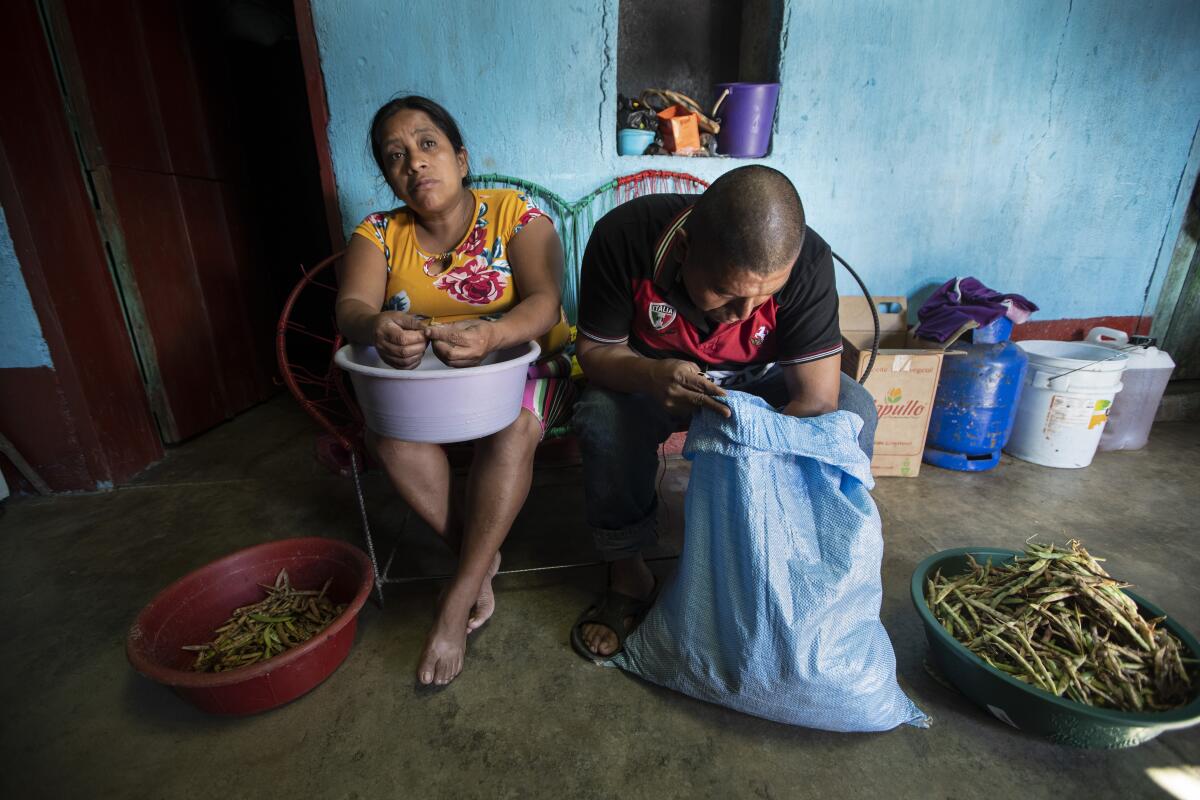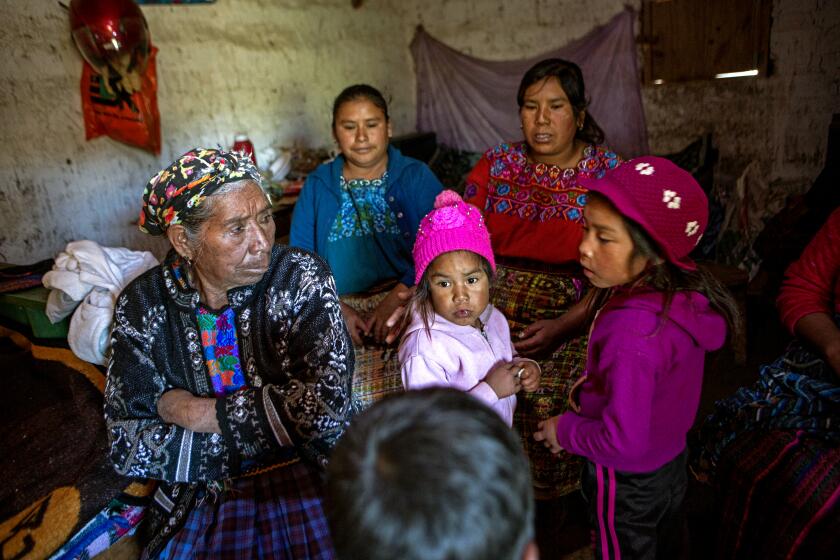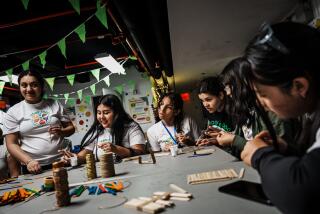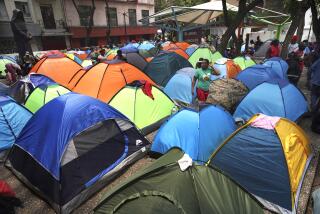Guatemalan lives are thrown into upheaval by failed immigration bids

TIZAMARTE, Guatemala — Alvina Jerónimo Pérez tries to avoid going out. She doesn’t want to see neighbors. She’s even changed the chip in her cellphone since her failed journey to the United States.
The 42-year-old woman is fearful her unsuccessful migration could cost her more than she can bear — even the single-story concrete block house her husband built on land passed down from her great grandparents in this mountaintop hamlet in south-central Guatemala.
Her husband, Anibal García, had recently added another room onto the back. The family had borrowed money to pay for the addition and was having trouble paying. Jerónimo thought she might be able to find the money if she migrated.
From afar, it seemed a safe bet. Many others in town, even in her own family, had made similar journeys. “Since people were passing [the border], we thought they were going to let us pass,” Jerónimo said.
The smuggler told her to bring her daughter to make it a sure thing, banking on the idea U.S. authorities wouldn’t deport a minor or her parent.
He promised her a job in the U.S. that would allow her to pay her debt.
So she put the house up as collateral to pay the smuggler $7,700. “The deal was that when we had arrived there, we were going to pay that money and they would return [the deed], but it wasn’t possible,” she said.
In March 2020, she and her daughter Yessenia, then 14, left Tizamarte. Three weeks later they were caught entering Texas. They were deported a week after that.
When Jerónimo realized they would be sent back, she cried. “I thought of everything the trip had cost me. I asked myself, ‘What am I going to do?’ I’ve lost everything.”
Nineteen burned bodies are found in an area in northern Mexico near the U.S. border that has a long history of horrific violence against migrants.
Jerónimo’s story is similar to that of thousands of Guatemalans who scramble to gather the money needed to migrate to the United States. Often it comes from relatives already living in the U.S. or networks of informal lenders. Sometimes migrants must sell their possessions, including their homes, or like Jerónimo, use the deeds as collateral. They are driven by the chance of breaking the cycle of poverty that affects 60% of the country’s population.
The COVID-19 pandemic initially blunted migration to the U.S. last year, but numbers were soon on the rise again. The U.S. Customs and Border Protection reported more than 30,000 encounters with Guatemalan migrants at the Southwest border this April.
President Biden put Vice President Kamala Harris in charge of finding ways to address the root causes of migration and Harris was scheduled to arrive in Guatemala on Sunday.
She has been talking with officials and nongovernmental groups about the forces at play, including poverty, corruption, violence and climate change. She has also expressed interest in groups historically facing discrimination including Indigenous peoples, African descendants and LGBTQ communities.
The Biden administration fears that an unmanageable number of migrants, especially children and families at the southwest border, will distract from its domestic policy goals even as it tries to present a more compassionate face than its predecessor.
Jerónimo is among more than 228,000 Guatemalans deported by the United States since 2015. For many of those, the dream failed. They were sent home with the stigma of failure and staggering debts that can’t be paid in a country where the minimum wage is about $11 per day.
She, like many others, sees no way out but to try again.
There’s an old and rusting white refrigerator in Jerónimo’s house, though most of the time it’s not plugged in: She often has no food that needs cooling and has to save money on electricity. Most of the time it just serves as a stand for the television perched on top.
In the dry winter months, the house is dark and cold under its corrugated tin roof. In the rainy season, it is hot and stifling. It sits close to the dirt road at the entrance to Tizamarte, a village of some 110 families, about 700 people.
A five-hour drive from Guatemala’s capital, Tizamarte is in the so-called “dry corridor,” a swath of land extending from southern Mexico to Panama where climate change has evolved into a series of punishing droughts and devastating tropical storms.
For people in Tizamarte and other settlements, that means eking out a living with subsistence agriculture to feed their families while harvesting coffee for cash to pay school fees or medicine.
Chiquimula, the department or state, where Tizamarte is located, accounts for 10% of Guatemala’s exported coffee, according to the National Coffee Assn., Anacafé.
During the coffee harvest from November to February, the village comes alive with an influx of cash, albeit modest. A picker makes about $8 per sack harvested and can usually fill one or two per day.
Jerónimo’s husband makes a little extra money by cooking up orders of fried chicken and french fries on a stove at home and selling them for a little under $2 to the pickers. Jerónimo sells basic groceries to passersby from a tiny store in the house’s front room.
The couple doesn’t pick coffee and does not have land to grow it. García raises corn and beans for their own consumption on a small rented plot. They typically get by on two meals a day of corn tortillas, beans and coffee.
Their home is unusual in town for having running water. Women and children line up at Tizamarte’s five public spigots to fill containers.
As in many other parts of Central America, migration to the north has become a tradition. Someone in nearly every family in town has gone to the U.S. or tried to.
A hospital said an immigrant’s hands may be amputated after he was found in the winter storm. Border Patrol told him he’d be sent back home, but he is now expected to stay in the U.S.
“Anyone who has the opportunity should go,” said Adán Rivera, a 40-year-old farmworker. “Migrating isn’t easy; you put yourself in danger. But there is need.”
Rivera himself takes his three young sons to harvest coffee because together they can fill three big sacks in a day, earning $24 versus just one he could fill alone.
“With that, you can buy more food,” Rivera said. But when the harvest is over, there’s little work, so people leave.
So many have left that much of the country survives on remittances they send home. Last year, that accounted for more than 14% of Guatemala’s gross domestic product — a flow of money that that trickles broadly through villages across the nation.
In Tizamarte, it’s during the hot months from March to October after the harvest is over, when wages and water dry up and food grows scarce, that people migrate. Last year, Jerónimo decided to join them.
She and her daughter left early one morning; she won’t say exactly how. Jerónimo carried a change of clothes in a small knapsack and 500 quetzales — about $65. It was the first time Jerónimo had traveled outside the department of Chiquimula near the Honduras border.
For three weeks mother and daughter walked, rode on buses and in cars. Jerónimo says she doesn’t recall the details of their route, but also clearly did not want to share them. What stuck in her memory was concern for her daughter, recalling a time when another migrant, frustrated that the girl’s weariness might slow the group, had threatened her. She remembered nights spent awake making sure no one tried to harm the teenager.
At the Mexico-U.S. border — Jerónimo says she doesn’t remember what part — they spent days locked inside a safe house before crossing into Texas, only to be apprehended hours after entering the U.S.
The U.S. Border Patrol held them together for seven days and put them on a plane back to Guatemala City. It was the first time Jerónimo had set foot in her country’s capital.
Jerónimo said neither she nor her daughter were tested for COVID after being detained or flown back — something that led to widespread complaints against the Trump administration’s deportation flights during the pandemic.
Guatemala’s health minister said in April 2020 — the same month Jerónimo and her daughter were deported — that deportees from the United States were driving up the country’s COVID-19 caseload, adding that on one flight some 75% of the deportees tested positive for the virus.
Last year, while much of the world was donning protective masks and learning about social distancing, life went on as usual in Tizamarte. There were few confirmed cases in the area — none in Tizamarte — and Jerónimo didn’t wear a mask until she was in Border Patrol custody. Guatemala has limited health services, especially in rural communities like Tizamarte, and has struggled to obtain COVID-19 vaccine. By the end of May, only 133 of the 61,000 residents in the municipality that includes Tizamarte had been vaccinated.
Jerónimo finally arrived back home without a cent. She had to ask a relative in the U.S. to wire her $50 to buy bus tickets back to Tizamarte.
Others in her family had migrated successfully in past years, though at least one attempt ended in tragedy.
Jerónimo’s son-in-law Santiago de León left in December 2018 with his 5-year-old son Wilman. They made it to the U.S. But when he found work, De León had no way to care for his son and sent him home to his wife on a commercial flight with a friend who had a visa.
Wilman was one of at least four children sent back to Tizamarte after helping their parents enter the U.S. in 2019 and 2020, residents recalled. De León sends his wife $125 each month to support their three children.
Encouraged by his brother’s successful journey, 16-year-old Juan de León left on his own for the U.S. in April 2019. Tránsito Gutiérrez, Juan’s mother, said he had left because he wanted to help the family, which sometimes had nothing to eat.
“Juanito” made it into Texas, but was detained by Border Patrol. While in custody he fell ill, was hospitalized and died in Corpus Christi. Guatemalan authorities said he died from a brain infection. He was sent back to Guatemala and buried in Tizamarte.
California’s Norma Torres fled Guatemala at 5. Now the only Congress member from Central America says the immigration debate is ‘very, very personal.’
Still, nearly a year later, Jerónimo decided she had to go.
She has been with García since they were teenagers. They have three children together, two of whom, Yessenia and her 20-year-old brother, live with them.
“The house is hers, the land is hers,” he said. “I built it, but there’s nothing in my name. She decided to go.”
With debts now hanging over the family, Jerónimo’s mind this past March turned again toward leaving. The coffee harvest — and her husband’s side business — have ended. Soon food would become scarce again.
“If I could, I would go,” Jerónimo said.
Fried chicken and frugality helped the family pay $650 toward the loan on the home addition, which was destroyed by tropical storms last year. But they still owe more on that. And there’s the $7,700 due for the failed migration attempt.
Smugglers in recent years have promised would-be migrants three tries at successfully crossing the U.S. border — an acknowledgment that it’s a large investment that doesn’t always pan out.
But Jerónimo had hired the smuggler through an intermediary — a neighbor who lives about 100 yards away — who apparently pocketed a significant portion of the fee, according to Jerónimo. So the smuggler refused to take her again.
That neighbor also had arranged a loan for Jerónimo — turning to a migrant living in the U.S. and his father, who lives in a town not far away.
Those lenders call and send text messages from time to time asking when she will pay. The first deadline was last October and Jerónimo asked for more time. The threats of seizing her house then became so frequent that Jerónimo changed the chip in her phone.
The anxiety of potentially losing the house affects Yessenia as well. The teenager says she’s willing to take the risk of trying on her own to return to the U.S.
“Losing the house and being left without anything scares me more,” she said.
Yessenia has been out of school for two years, because even before the pandemic her parents couldn’t afford the school fees. She used to dream of being a police officer and fantasizes about being able to study again and buy new clothes, but the risk to the house looms over everything.
“I want to save the house and the deed to not be in the hands of someone else, but in our hands,” she said. “So to help my mom I’m going.”
Yessenia’s parents disagree. If there’s a way, even if it means risking more debt, Jerónimo said she herself will go.
“That is what makes you desperate enough to migrate,” she said. “It’s pure necessity.”
This story was supported by the International Women’s Media Foundation.
More to Read
Sign up for Essential California
The most important California stories and recommendations in your inbox every morning.
You may occasionally receive promotional content from the Los Angeles Times.












